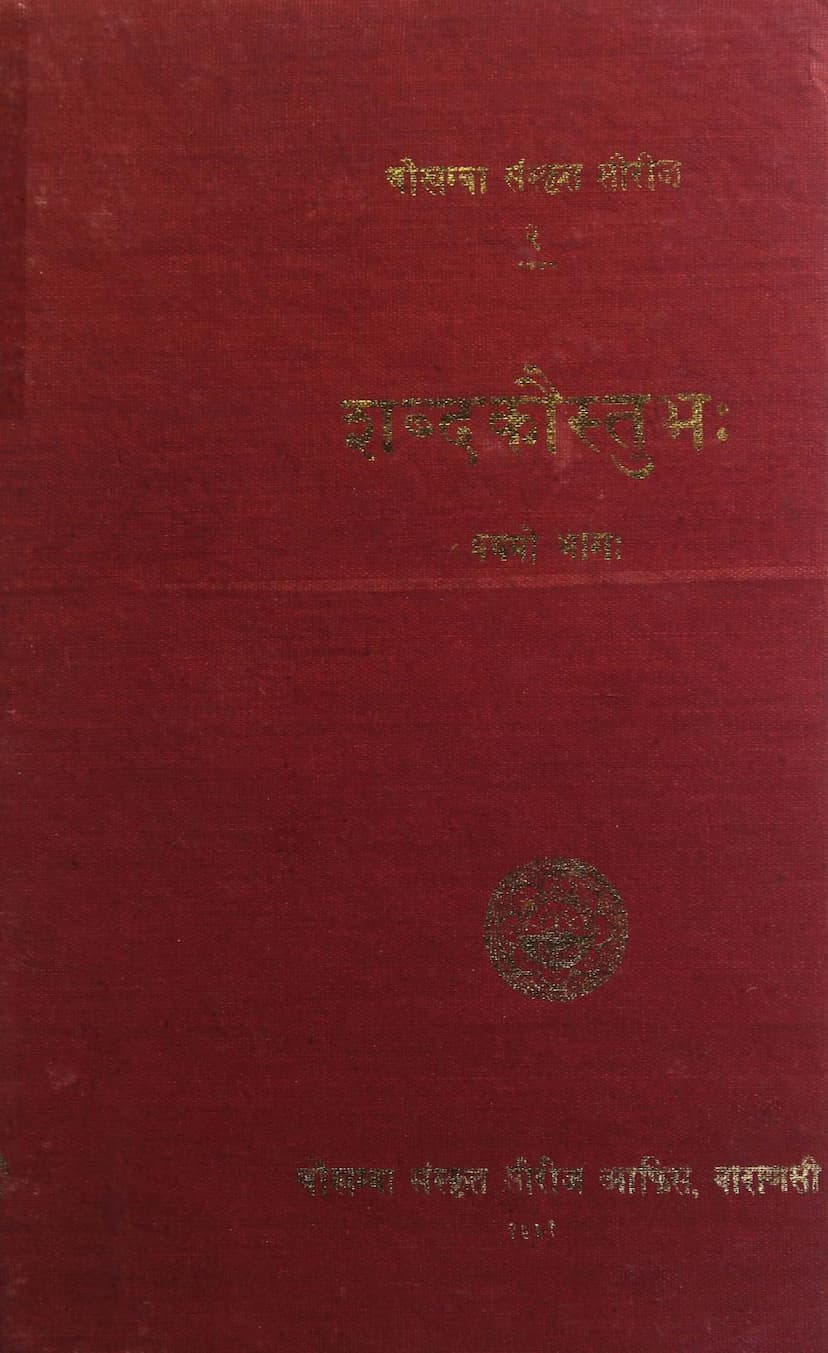Shabda Kaustubh Part 01
Added to library: September 2, 2025

Summary
Here's a comprehensive summary of the provided Jain text, "Shabda Kaustubh Part 01" by Bhattoji Dikshit, based on the provided pages:
Book Title: Shabda KaustMubha Part 01 Author: Bhattoji Dikshit Publisher: Chowkhamba Sanskrit Series Reprint Year: 1991
Overall Nature of the Text:
Shabda Kaustubha (शब्दकौस्तुभ) is a highly respected and comprehensive commentary on Panini's Ashtadhyayi, the foundational text of Sanskrit grammar (व्याकरण - Vyakarana). This specific volume, Part 01, delves into the initial sections of the Ashtadhyayi, laying the groundwork for understanding Sanskrit grammar. The text is written in classical Sanskrit prose, rich with grammatical terminology, philosophical discussions, and references to earlier authoritative texts and scholars.
Key Themes and Content Covered (based on the provided pages):
The provided pages (primarily the "Bhumika" - Introduction and the "Vishaya Nirupan" - Table of Contents) reveal the scope and depth of this volume. The focus is on establishing the fundamental principles and the subject matter of grammar, along with its purpose and the nature of language itself.
1. The Importance and Purpose of Grammar (व्याकरण):
- Vedanga: Grammar is presented as a primary and essential limb (मुखमिव प्रधानमिदं) of the Vedas (Vedanga), crucial for understanding them correctly. It's emphasized that the Vedas should be studied with their six Angas (षडङ्गो वेदोऽध्येयो शेयश्च), and grammar is the most important among them.
- Protection of the Vedas: Grammar serves to protect the Vedas from corruption, especially from the intrusion of incorrect or meaningless words (रक्षा वेदसंरक्षणम्).
- Clarity and Correctness: It helps in distinguishing between correct (साधु) and incorrect (अपशब्द) words, which is vital for understanding the true meaning of Vedic and secular texts.
- Purpose of the Text: The introduction highlights that Bhattoji Dikshit aimed to distill the essence of the vast grammatical ocean (भाष्पाब्धि) presented by Patanjali in his Mahabhashya, making it accessible to scholars.
2. Subject Matter of Grammar (विषय):
- Words (Shabda): The primary subject of grammar is identified as words, both Vedic (वैदिकाः) and secular (लौकिकाः).
- Correctness (Sadhutva): A significant portion is dedicated to defining and understanding what constitutes a "correct" word (साधुशब्द). This involves discussions on concepts like etymology (व्युत्पादन), the role of roots (प्रकृति), affixes (प्रत्यय), phonetic rules, and the principles of derivation.
- Sphota Theory (स्फोटनिरूपण): The text delves into the philosophical concept of Sphota, the indivisible sound-essence of language that conveys meaning, discussing various theories like word-sphota, sentence-sphota, etc.
- Pāṇini's Sutras: The commentary meticulously analyzes and explains the meaning and purpose of Panini's Sutras (सूत्र) and the grammatical rules they establish.
3. Key Concepts Discussed in Detail (from the Table of Contents): The table of contents outlines a detailed exploration of various grammatical concepts:
- Nature of Language: Discussions on the nature of words, the relationship between words and meaning, and the purpose of studying grammar.
- Phonetics and Sound: Analysis of alphabets (वर्ण), their properties (e.g., vivrita vs. saṃvrta of 'a'), the purpose of phonetic enumeration (वर्णसमाम्नायप्रयोजनम्), and the treatment of sounds in sandhi (सन्ध्यभावः).
- Grammatical Categories and Rules:
- Sanjnas (संज्ञा - technical terms): The text explains various sanjnas like sthānin (where a form resides), adesha (substitutes), sphota, pratyaya lakshana (rules for continuation), vruddhi (augment), guna (vowel change), savarna (similar sounds), pragṛhya (special handling of certain vowels), ghu, ati-desha (analogy/transfer of rules), samkhya (number-related rules), nishtha (perfect passive participle markers), sarvanama (pronouns), avyaya (indeclinables), sarvanamasthana (a specific case marker), vibhasha (options), samprasaraṇa (vowel interchange), agama (addition of sounds), adesha (substitution), antar Tama (most similar), aparadesha (R-para rule), and sarvadesha (total substitution).
- Definitions and Refutations: The work goes into defining these terms and refuting alternative interpretations, showcasing a rigorous scholarly approach.
- Etymology and Meaning: The text explores how words are formed and how their meanings are derived, including discussions on jati (universal) vs. vyakti (particular) in word meanings.
- Refutation of Opposing Views: The author often addresses and refutes grammatical theories or interpretations from other schools of thought or earlier grammarians.
4. Scholarly Context and Lineage:
- Appreciation for Tradition: The introduction emphasizes the lineage of grammatical scholarship, paying homage to Panini, Katyayana (Varttikakara), and Patanjali (Mahabhashyakara).
- Bhatta-ji Dikshit's Contribution: Bhattoji Dikshit is presented as a scholar who synthesized and clarified the profound teachings of the Mahabhashya, making them more accessible.
- Editors and Publishers: The reprint acknowledges the editors (Vindhyeshwari Prasad Dwivedi and Ganapati Shastri Mokate) and the publisher (Chowkhamba Sanskrit Series Office, Varanasi), indicating a modern academic effort to bring this classical work to light.
- Support for Publication: The mention of financial assistance from the Government of India's Ministry of Human Resource Development highlights the academic and cultural significance of this publication.
5. Jain Aspect: While the core of the text is Sanskrit grammar, the catalog link suggests a Jain context for this specific edition. The presence of the Jain Education International logo and the phrase "FOR PRIVATE AND PERSONAL USE ONLY" on the initial pages point to this specific edition being curated or distributed within a Jain educational framework. The summary of contents, however, focuses on the universally recognized grammatical principles within the Sanskrit tradition, as expounded by Bhattoji Dikshit. It's possible the Jain context refers to the specific editorial or archival presentation rather than the subject matter of the grammar itself, unless Bhattoji Dikshit, known for his Shiva devotion, also had significant Jain leanings which is not explicitly stated in these pages. However, the vast majority of the content discussed pertains to the traditional study of Panini's grammar.
In essence, Shabda Kaustubha Part 01 is a foundational text in Sanskrit grammar, offering a detailed, analytical, and often philosophical exploration of the building blocks of language, as expounded by one of the most influential grammarians after Panini himself.